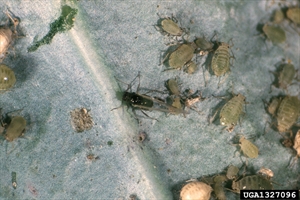- Worldwide distribution. On plants in cabbage family and related weeds. An important pest.
- Infestations cause: (i) curling, yellowing and stunting, especially mustards; (ii) honeydew that spoils quality; and (iii) spread of viruses.
- Adults 1.7 mm long. Wingless - greenish-yellow, covered in fine wax, with green bands along top of the body, and dark antennae. Winged - shiny black heads and prothorax (segment behind head), and green abdomen. In tropics, females give birth to living young without mating.
- Spread by winged forms in wind currents.
- Natural enemies: many predators and parasitoid wasps (e.g., Diaeretiella, Aphidius, Aphelinus).
- Cultural control: nursery hygiene: clean trays, pasteurise soil or use soilless mixes; avoid planting next to, or down-wind from infested crops; weed; remove infested leaves; destroy ant colonies with boiling water (or insecticides); collect and destroy debris after harvest.
- Chemical control: (i) PDPs (derris, chilli, garlic, neem, pyrethrum); (ii) soap solution, horticultural or white oils (see Fact Sheet no. 56). Avoid broad-spectrum products. Only use e.g., synthetic pyrethroids to kill ants.






